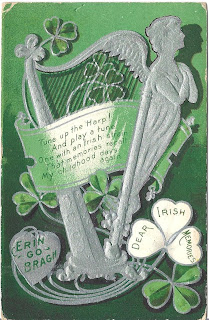A postcard a day, from a large collection of postcards received, sent to me by me, and/or collected over the last 30+ years.
Friday, March 12, 2010
St. Patrick's Day
It's Postcard Friendship Friday, and the posting of postcards for St. Patrick's Day has begun, with the theme suggested by the event's new hostess.
Both of these cards were sent in 1911, and are part of my friend Debra's holiday postcard collection she got from her grandmother.
I had to look up the origins of St. Patrick's Day, and it turns out the Irish have been commemorating the day for over 1000 years.
This from History.com: "St. Patrick's Day is celebrated on March 17, his religious feast day and the anniversary of his death in the fifth century. The Irish have observed this day as a religious holiday for over a thousand years. On St. Patrick's Day, which falls during the Christian season of Lent, Irish families would traditionally attend church in the morning and celebrate in the afternoon. Lenten prohibitions against the consumption of meat were waived and people would dance, drink and feast—on the traditional meal of Irish bacon and cabbage."
And so it could be said that St. Patrick's Day started as a way to get out of the restrictions of Lent, at least for a day!
Also had to look up the significance of the harp, seen in both postcards.
From Wikipedia: "Until the end of the Middle Ages the Gaelic harp (the historical clarsach or Irish harp) was the highest status musical instrument of both Scotland and Ireland, and harpers were amongst the most prestigious cultural figures amongst Irish and Scottish kings and chiefs. In both countries, the harper enjoyed special rights and played a crucial part in ceremonial occasions such as coronation and poetic recital. The main function of the Gaelic harp in medieval Scotland and Ireland seems to have been playing to accompany the recitation of bardic poetry in Gaelic or Irish.
And from Symbols of Ireland: "The harp has long been a symbol of Ireland. Perhaps the legends of it's magical powers comes from the time when the bards would sing and tell stories of famous events to the Irish kings and chiefs. During the early 1500s, under the rule of Henry VIII, the harp was first depicted on Irish coins. That tradition is carried on today and the harp is also used for other official duties such as the Irish state seal, official documents and uniforms."
Finally, it's too bad metalic silver doesn't show well on-line, as both cards are actually metallic silver where they look grey.
Erin go bragh!
.jpg)

Beautiful cards. I'm glad to know about the significance of the harp - and I'm glad you went to the work to research it. The one on the right is quite possibly the prettiest St. Patrick's day card I have ever seen.
ReplyDeleteHappy St. Patrick's Day and PFF!
ReplyDeleteGreat postcard. Happy PFF.
ReplyDeleteYeah, I have lamented about the metallics not showing up, too. It is a shame. Very pretty.
ReplyDeleteThanks for stopping by Mary, I love your card. I've limited my past collection to History of Costume and personal connection, I suppose I should expand my horizons. Have a good one.
ReplyDeleteI loved the detail of the history of the harp.
ReplyDeleteI am an Irish American and I LOVE the harp. I've often thought if I could get my mits on a harp I could play it beautifully.
I REALLY appreciate all the info, and especially those wonderful postcards!
Happy PFF!
AND Happy St. Paddy's Day! May the luck of the Irish be with you. (grin)
interesting information about Harpist... thanks for sharing... Happy PFF
ReplyDeleteIt's interesting that the harp has remained a national symbol for Ireland but not for Scotland. I grew up in Ireland and long after we moved away, my grandmother would send shamrock for St Patrick's Day.
ReplyDeleteWonderful postcards and love to read and learn interesting facts. Thanks for sharing!
ReplyDeleteBlessings & Aloha!
Thank you for stopping by :o)